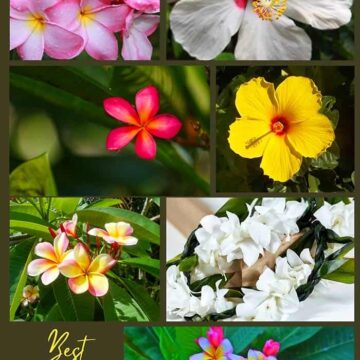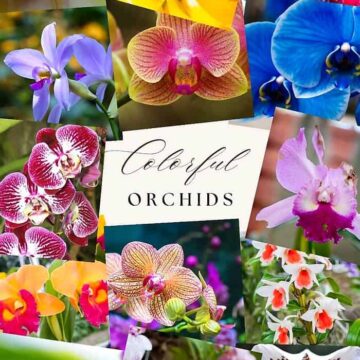25 Most Famous & Dangerous Bug Eating Plants
Carnivorous plants derive most of their nutrients by consuming animals. Know more about them as this article features the 25 most famous carnivorous plants.
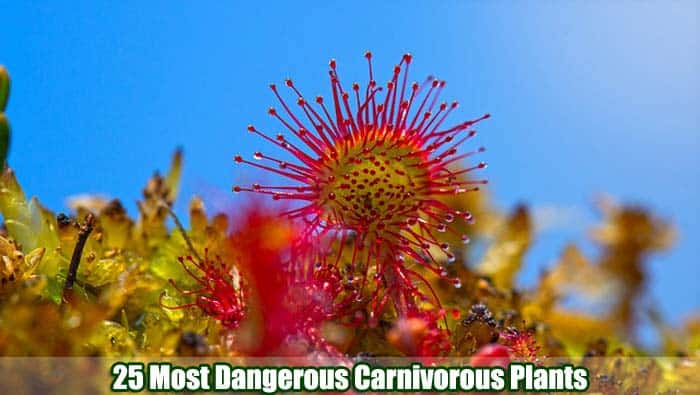
Carnivorous Plants: Animals eating plants is a common thing. What about the other way around? Is this even possible?
By definition, the word carnivory refers to the practice of organisms deriving their energy and nutrient requirements through predation. Moreover, yes, (some) plants can consume animals too.
For instance, this adaptation is called plant carnivory, and this refers to the ability of some plants to trap and consume insects and other small animals. However, what would make a plant select a diet of insects or meat?
While they certainly make use of photosynthesis to make their food and generate energy, these kinds of plants make up their protein intake by trapping and eventually digesting insects and small animals.
Also, carnivorous plants are not rare, but they usually thrive in habitats with extreme environmental conditions. They live in extreme habitats where the soil generally lacks nutrients, and these kinds of plants have turned to other sources.
However, again, contrary to the term “carnivorous“, these plants do not eat or consume flesh and meat. Therefore, they are harmless to humans.
Are you excited yet?
The fantastic world of bug eating plants is worth exploring! Here are the 25 most famous and most dangerous carnivorous plants.
Jump to:
Carnivorous Plants
1. Venus Flytrap (Dionaea Muscipula)
| Kingdom | Order | Family | Genus | Species |
|---|---|---|---|---|
| Plantae | Caryophyllales | Droseraceae | Dionaea | Dionaea muscipula |
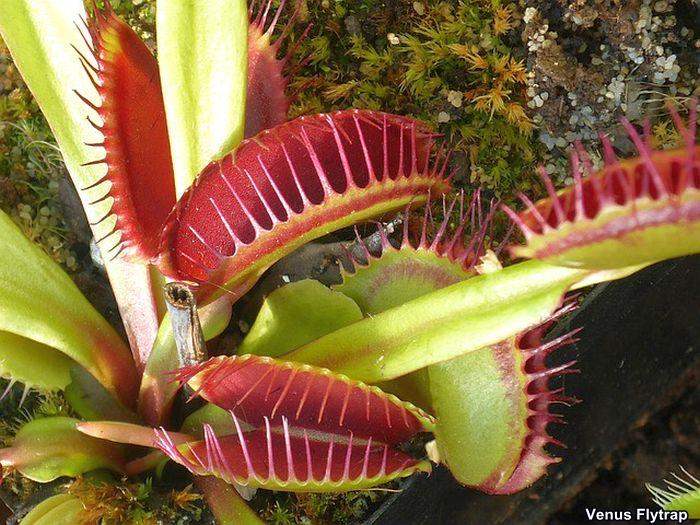
Indigenous to North and South Carolina, the Venus flytrap is probably the most classic and the meanest carnivorous plant of all.
- Most of the time, these predatory plants thrive in nutrient-poor soils and thus practice carnivory to get more nutrients from insects.
- The leaves of this carnivorous plant are characterized by having stiff sensitive hairs. If by any chance, these hairs are touched, the two lobes of the leaves will snap shut, trapping anything inside.
- Interestingly, in about twelve hours, when the plant realizes that the object is not food, the leaves will open and spit the trap out.
- Because of the over-fascination of people with these plants, many of them are now becoming endangered.
- The Venus flytrap is a monotypic genus, meaning it is the only species (D. muscipula) in its genus (Dionaea).
![]()
2. Waterwheel Plant (Aldrovanda Vesiculosa)
| Kingdom | Order | Family | Genus | Species |
|---|---|---|---|---|
| Plantae | Caryophyllales | Droseraceae | Aldrovanda | Aldrovanda vesiculosa |
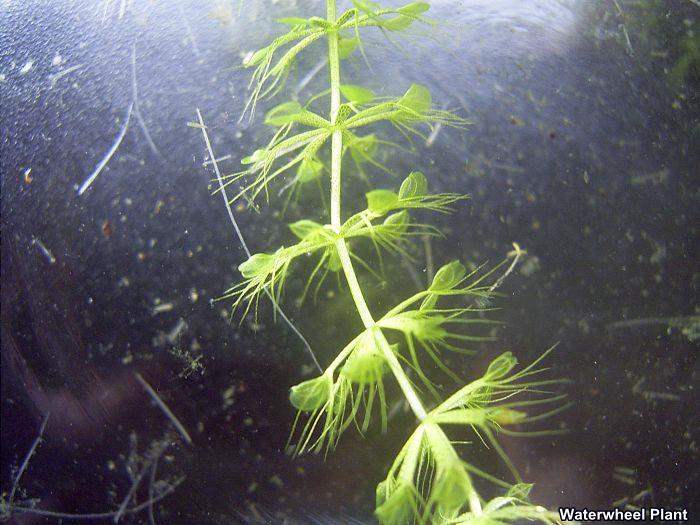
The Waterwheel plant is a rootless and free-floating aquatic plant closely related to the Venus flytrap. Like the flytrap, this plant is a snapping trap with delicate, sensitive hairs, only underwater!
- This plant is characterized by a single whorl of leaves shaped like a wheel (hence the name).
- The genus name of this plant was initially derived from its Italian discoverer, Ulisse Aldrovandi. However, the famous taxonomist who cataloged the plant misspelled it as “Aldrovanda” instead.
- Hence, at present, we use the incorrect spelling of the name.
![]()
3. Sundew (Drosera Sp.)
| Kingdom | Order | Family | Genus | Species |
|---|---|---|---|---|
| Plantae | Caryophyllales | Droseraceae | Drosera | Drosera sp. |
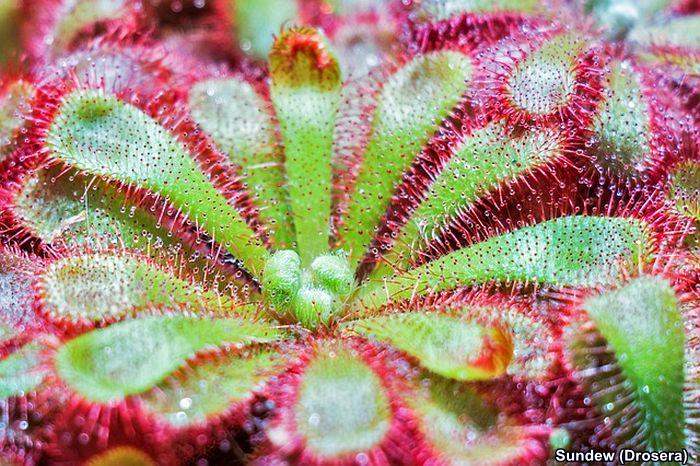
Also known to be the “master of sticky fly paper“, the Sundew Drosera is an insect trap that captures its prey with its numerous sticky hairs. These hairs produce digestive enzymes (like proteases and phosphatases) that tend to degrade the trapped prey.
- The common name of this plant is derived from the characteristics of its leaves to shine like dew in the sun.
- Compared to the Venus flytrap, these fly-eating plants are relatively slower.
![]()
4. Albany Pitcher Plant (Cephalotus Follicularis)
| Kingdom | Order | Family | Genus | Species |
|---|---|---|---|---|
| Plantae | Oxalidales | Cephalotaceae | Cephalotus | Cephalotus follicularis |
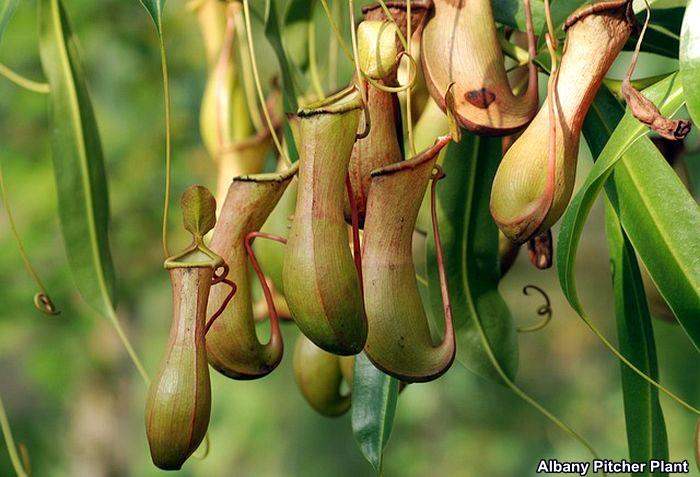
First discovered in southern Australia by French explorer Bruni d'Entrecasteaux, the Albany Pitcher plant Cephalotus follicularis is a monotypic genus. In addition to that, it is the only species in the plant family Cephalotaceae.
- This low-growing plant is characterized by having hairy pitfall traps with two kinds of leaves: the carnivorous pitcher leaves and the non-carnivorous ones.
- This carnivorous plant typically grows its non-carnivorous leaves to provide energy to the plant (from photosynthesis) before growing its pitchers.
- Its scientific name Cephalotus follicularis was derived from the Greek word “kephalotus" which means “headed“, and from the Latin word “folliculus" which means “a little sack“. Such names describe the filaments of the stamens and the shape of the plant's pitchers.
![]()
5. Cobra Lily (Darlingtonia Californica)
| Kingdom | Order | Family | Genus | Species |
|---|---|---|---|---|
| Plantae | Ericales | Sarraceniaceae | Darlingtonia | Darlingtonia californica |
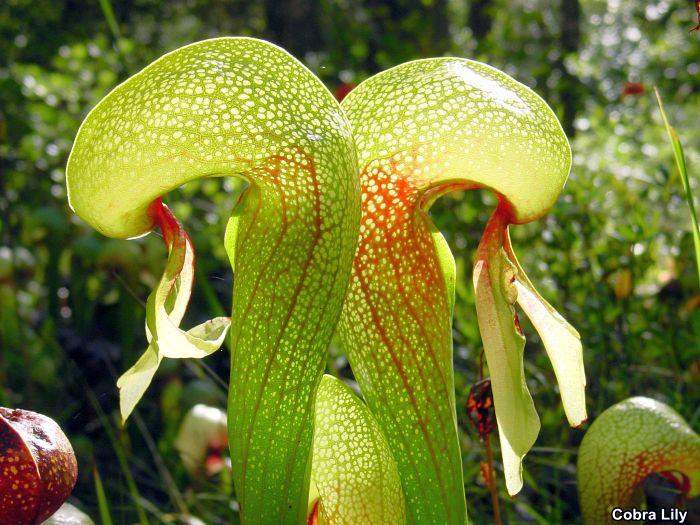
The next carnivorous plant is Endemic to Northern California and Southern Oregon; the Cobra lily is a carnivorous plant that has evolved various mechanisms to trap and digest prey.
- Also called the California pitcher plant, this plant lures insects into its pitcher-like modified leaf with nectar on its downward-facing opening.
- Its common name is derived from its pitcher which is cobra-like in appearance.
![]()
6. Dewy Pine (Drosophyllum Lusitanicum)
| Kingdom | Order | Family | Genus | Species |
|---|---|---|---|---|
| Plantae | Caryophyllales | Droseraceae | Drosophyllum | Drosophyllum lusitanicum |
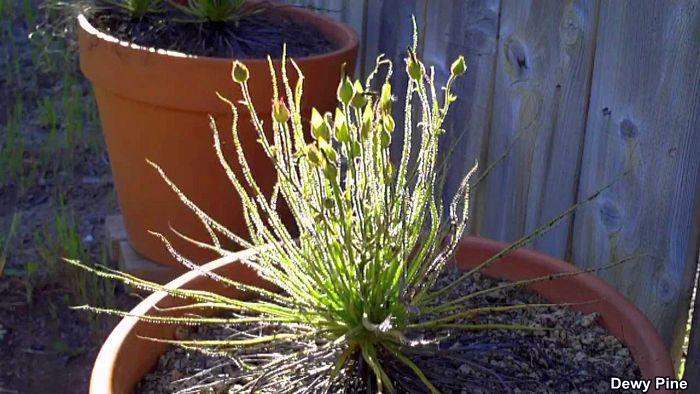
The next plant in this our list is the Dew pine Drosophyllum lusitanicum, which is indigenous to Portugal, Spain, and Morocco.
- Interestingly, these plants lure prey by emitting honey, which mimics the black when it lives in the wild.
- When young, these plants need an ample water supply, but as they grow older, their need for water becomes less.
![]()
7. Heliamphora (Heliamphora Sp.)
| Kingdom | Order | Family | Genus | Species |
|---|---|---|---|---|
| Plantae | Ericales | Sarraceniaceae | Heliamphora | Heliamphora sp. |
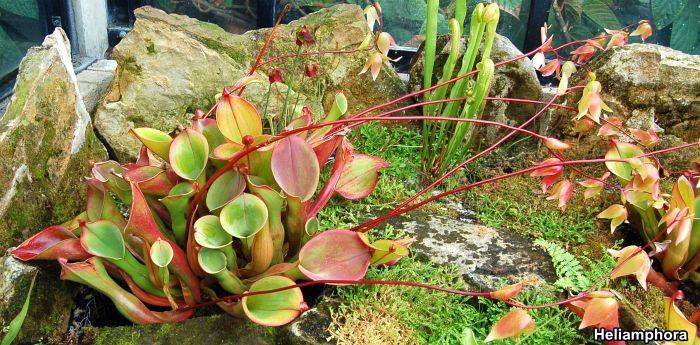
Native to both tropical and high altitudes, the Heliamphorais is a carnivorous plant that has rolled leaves and fused axes that form the body of the tubular traps.
- According to studies, this plant is not good at catching insects, which is most likely based on the average number of insects trapped at the bottom of its leaves.
- The name of this plant is derived from the same word, which means “marsh pitcher” as this plant is commonly found in those kinds of habitats.
![]()
8. Butterworts (Pinguicula Moranensis)
| Kingdom | Order | Family | Genus | Species |
|---|---|---|---|---|
| Plantae | Lamiales | Lentibulariaceae | Pinguicula | Pinguicula moranensis |
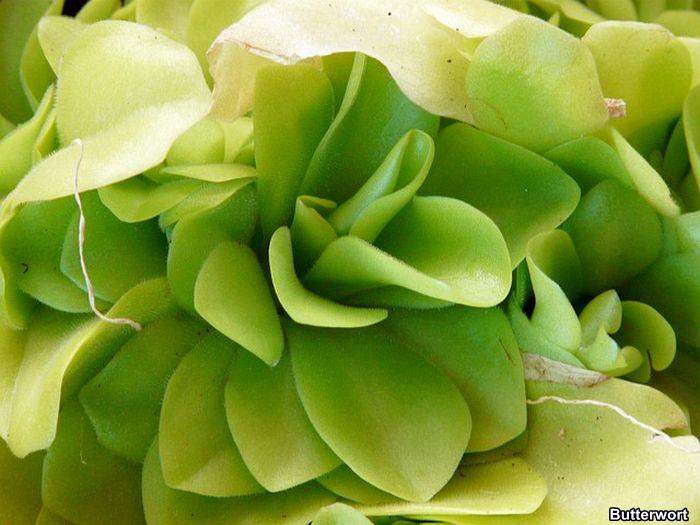
Native throughout North America to Siberia and from Central to South America, the Butterwort Pinguicula is a small herbaceous plant famous for its flowers pollinated by hummingbirds.
- In Latin, the word “Pinguicula” literally means “little greasy one“, concerning its greasy feel when touched.
- The leaves of these plants are covered in short sticky hairs that secrete enzymes and acids that can dissolve and degrade their prey.
![]()
9. Bladderwort (Utricularia)
| Kingdom | Order | Family | Genus | Species |
|---|---|---|---|---|
| Plantae | Lamiales | Lentibulariaceae | Utricularia | Utricularia sp. |
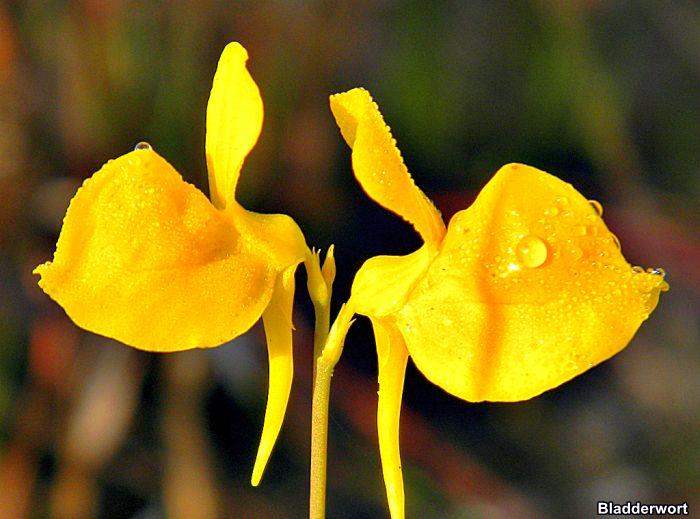
The Bladderwort Utriculariais is a free-floating annual plant that has no roots yet has flowers and rigid stems.
- These plants are unique in the sense that their underwater leaves with “bladders” that can catch and dissolve prey.
- Most of the time, bladderworts thrive in acidic and shallow waters.
- In terms of food value for plants and wildlife, this plant has no value, but it can serve as a habitat for small fish and insects.
![]()
10. North American Pitcher Plant (Sarracenia Sp.)
| Kingdom | Order | Family | Genus | Species |
|---|---|---|---|---|
| Plantae | Ericales | Sarraceniaceae | Sarracenia | Sarracenia sp. |
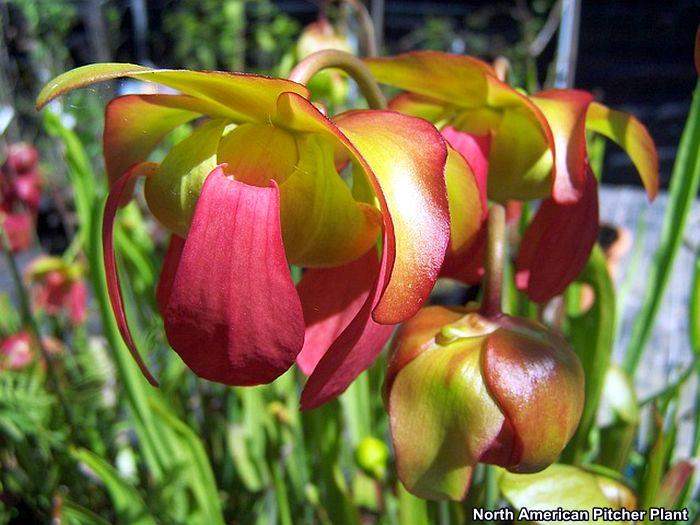
The North American Pitcher plant Sarracenia is a type of carnivorous plant known to inhabit the lakes of Texas, the eastern seaboard, and Canada, hence its name.
- Like most of the plants in this list, this kind of pitcher prey on insects without moving any body parts.
- Its trap consists of luring insects with its sweet scent, nectar, and funnel-shaped leaves containing digestive enzymes to digest its prey.
- To avoid rainwater from diluting these enzymes, this plant has developed a hood-like structure above its opening.
Suggested Reading:
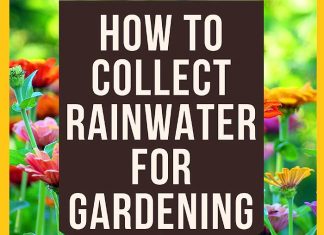
How To Collect Rainwater For Gardening?
![]()
11. Tropical Pitcher Plant (Nepenthes Sp.)
| Kingdom | Order | Family | Genus | Species |
|---|---|---|---|---|
| Plantae | Caryophyllales | Nepenthaceae | Nepenthes | Nepenthes sp. |
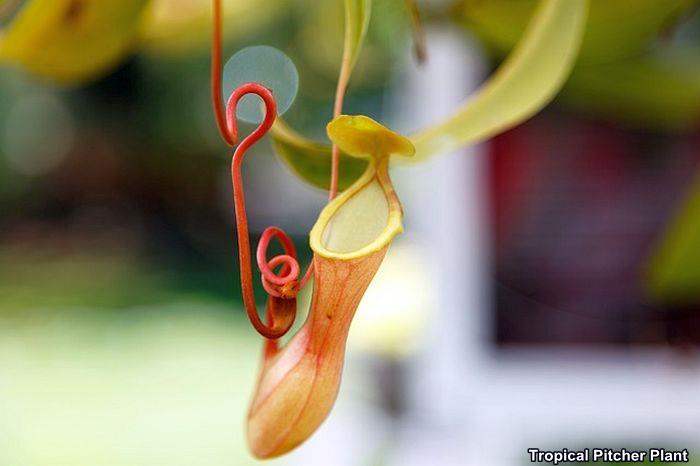
The Tropical Pitcher plant Nepenthes is another carnivorous pitcher plant indigenous to tropical regions like Southeast Asia and India.
- Due to its attractive scent and appearance, insects and other small animals become encouraged to fall into its pitcher-like leaves containing digestive enzymes at the bottom of the trap.
- Interestingly, the Tropical Pitcher plant is also called “Monkey cups” because of the habit of tropical monkeys to drink the fluid from the pitchers.
![]()
12. Attenborough’s Pitcher Plant (Nepenthes Attenboroughii)
| Kingdom | Order | Family | Genus | Species |
|---|---|---|---|---|
| Plantae | Caryophyllales | Nepenthaceae | Nepenthes | Nepenthes attenboroughii |
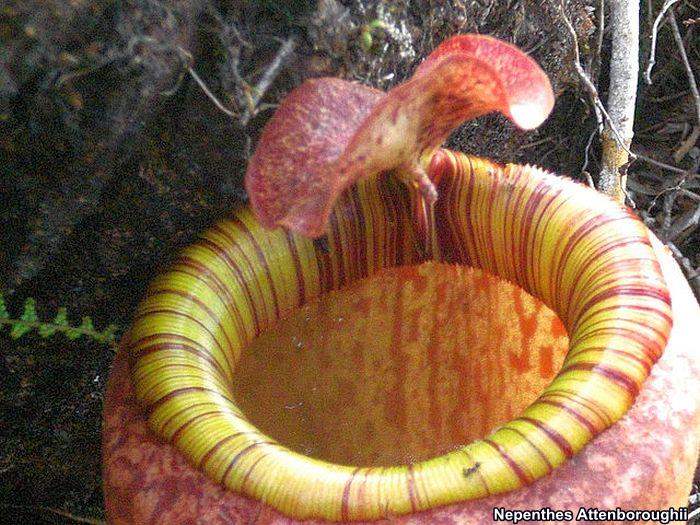
This next plant is the Attenborough's Pitcher plant, known to be found only in the slopes and summit of Mount Victoria in central Palawan, Philippines.
- Like any other pitcher plant, the Attenborough's pitcher plant has a funnel-like leaf structure where insects become trapped in and eventually digested.
- Because of its low seed-variability and dispersion and the rampant collection of tourists, this plant is tough to grow and nearly endangered.
- This species of pitcher plant is named after the famous British natural history broadcaster David Attenborough.
![]()
13. Rafflesia Pitcher Plant (Nepenthes Rafflesiana)
| Kingdom | Order | Family | Genus | Species |
|---|---|---|---|---|
| Plantae | Caryophyllales | Nepenthaceae | Nepenthes | Nepenthes rafflesiana |
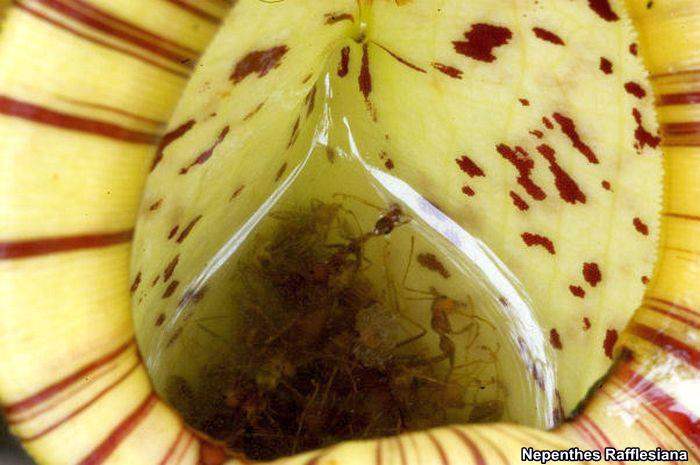
Nepenthes? Rafflesia? Both sound familiar, right?
- This species of pitcher plant is widespread in the lowland areas of Borneo (specifically Brunei), Malaysia, and Singapore.
- Unlike other pitcher plants, this species of Nepenthes is often visited by insects. However, it appears that it does not specialize in degrading them as its fluid is not of viscous consistency.
- This species of Nepenthes is highly variable and comes in a wide variety of sizes, colors, and forms.
![]()
14. Side-Saddle Flower (Sarracenia Purpurea)
| Kingdom | Order | Family | Genus | Species |
|---|---|---|---|---|
| Plantae | Ericales | Sarraceniaceae | Sarracenia | Sarracenia purpurea |
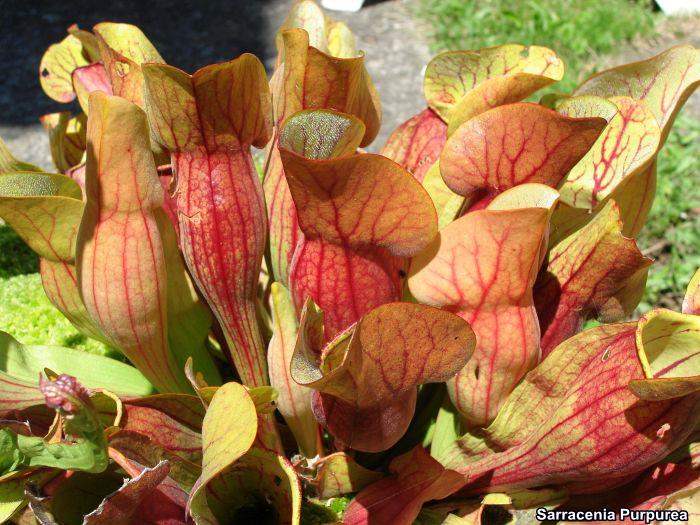
Known as the Side-saddle flower or the Purple Pitcher plant, the Sarracenia purpurea, is a carnivorous flowering plant endemic to North America and some parts of Europe.
- Like any other species of Sarracenia and plants in this list, this plant obtains nutrients most of its nutrients from its prey.
- It uses its pitcher-like leaf structure, which contains digestive enzymes to dissolve them.
- Some Native American tribes utilize this plant as a source of medicine.
![]()
15. Yellow Pitcher Plant (Sarracenia Flava)
| Kingdom | Order | Family | Genus | Species |
|---|---|---|---|---|
| Plantae | Ericales | Sarraceniaceae | Sarracenia | Sarracenia flava |
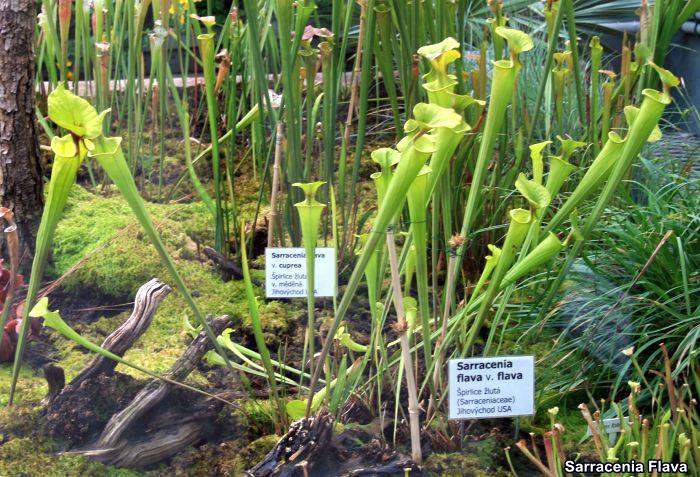
The next plant in this list is the Yellow Pitcher plant, which is considered as one of the tallest pitcher plants in the world.
- This plant has pitcher-shaped leaves which primarily serve to attract insects with nectar, trap them inside, and dissolve them while alive.
- This plant is easily distinguished from other pitcher plant species from its distinct yellow-green (with sometimes red veins) pitchers.
![]()
16. Parrot Pitcher Plant (Sarracenia Psittacina)
| Kingdom | Order | Family | Genus | Species |
|---|---|---|---|---|
| Plantae | Ericales | Sarraceniaceae | Sarracenia | Sarracenia psittacina |
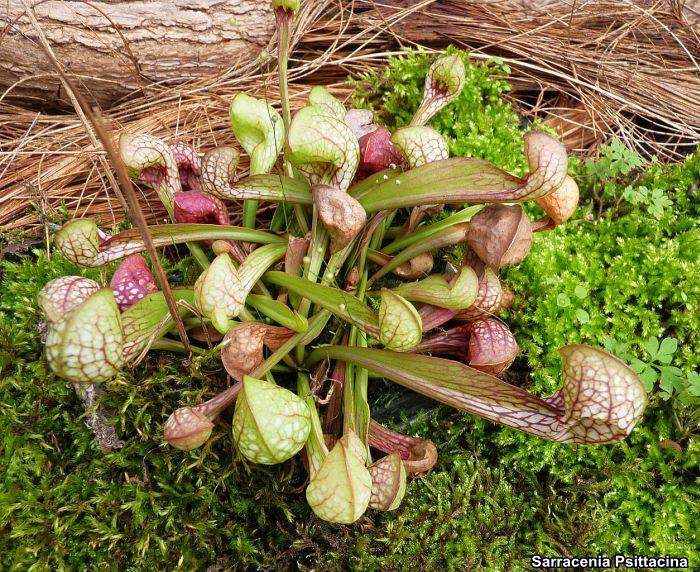
The Parrot Pitcher plant Sarracenia psittacina is a type of carnivorous plant found to inhabit the boggy areas of pine forests.
- This plant’s mature pitcher leaf structure is characterized by a red purple-hood that resembles a parrot (hence its name).
- Interestingly, the Exyra moth is one of the few insects that can live inside the pitcher but does not get killed.
![]()
17. Veitch’s Pitcher-Plant (Nepenthes Veitchii)
| Kingdom | Order | Family | Genus | Species |
|---|---|---|---|---|
| Plantae | Caryophyllales | Nepenthaceae | Nepenthes | Nepenthes veitchii |
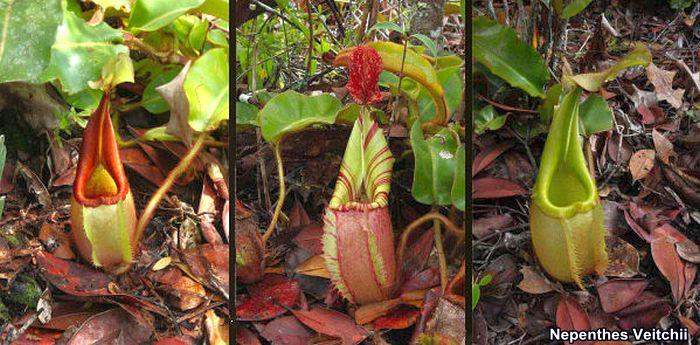
Indigenous to the Hose Mountain of Sarawak, Borneo, the Veitch Pitcher plant is very famous for having one of the largest peristome (opening of the pitcher) among the genus Nepenthes.
- Interestingly, this plant grows via its stem elongating horizontally rather than vertically.
- This species of Pitcher plant is also unique as it can thrive in cold highland temperatures.
![]()
18. Byblis (Byblis Sp.)
| Kingdom | Order | Family | Genus | Species |
|---|---|---|---|---|
| Plantae | Lamiales | Byblidaceae | Nepenthes | Byblis sp. |
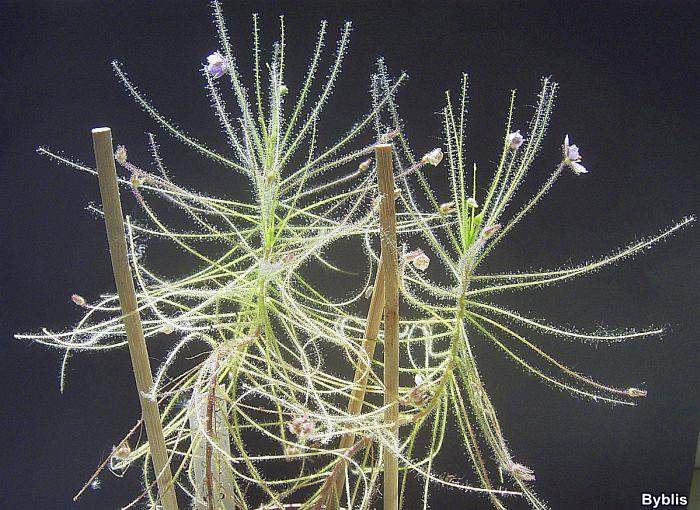
The next carnivorous plant is the Byblis, a carnivorous desert plant that somehow resembles a sundew.
- It is characterized by sticky hairs that can trap insects because they are deceived into thinking they are nectar.
- However, unlike the sundew, the hairs of the Byblis do not curl around the captured insect.
- In Australia (where it is endemic), this plant is also called the Rainbow plant.
![]()
19. Triphyophyllum Peltatum
| Kingdom | Order | Family | Genus | Species |
|---|---|---|---|---|
| Plantae | Caryophyllales | Dioncophyllaceae | Triphyophyllum | Triphyophyllum peltatum |
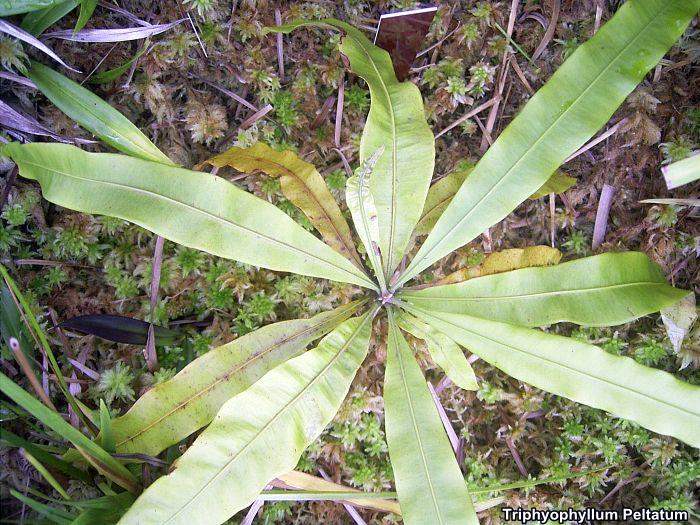
Regarded as the largest carnivorous plant, the Triphyophyllum peltatum is restricted to West Africa.
- Interestingly, this plant produces three types of leaves: (1) lance-shaped leaves, (2) small leaves that terminate with hooks, and (3) carnivorous leaves that have glands that produce enzymes to dissolve its prey.
- Concerning the above, this plant can produce hooks that can grow as long vines with 70 meters length!.
![]()
20. Brocchinia Reducta
| Kingdom | Order | Family | Genus | Species |
|---|---|---|---|---|
| Plantae | Poales | Bromeliaceae | Brocchinia | Brocchinia reducta |
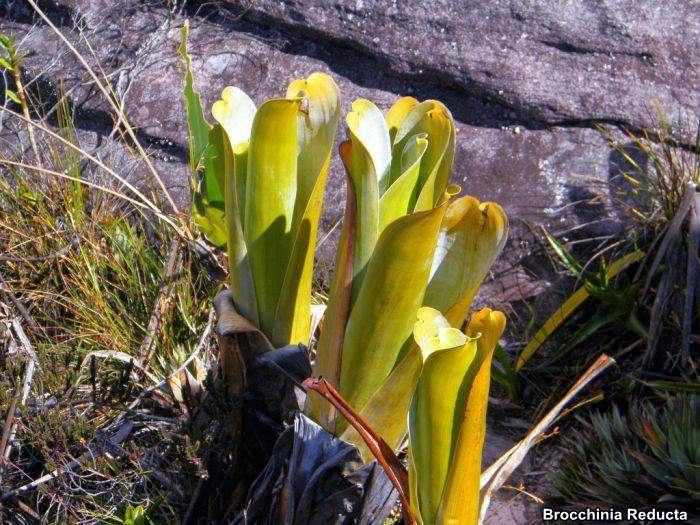
The Brocchinia reducta is a carnivorous plant characterized by its leaves shaped like an organ pipe.
- These organ pipe-like leaves are not hollow, but instead, they are filled with water and “juices” from the insects that fell into the trap.
- Its genus name Brocchinia, is derived from the name of its Italian discoverer, Giovanni Battista Brocchi.
- This plant is endemic to South America, especially to Venezuela, Brazil, and Colombia.
![]()
21. Trigger Plants (Stylidium Sp.)
| Kingdom | Order | Family | Genus | Species |
|---|---|---|---|---|
| Plantae | Asterales | Stylidiaceae | Stylidium | Stylidium sp. |
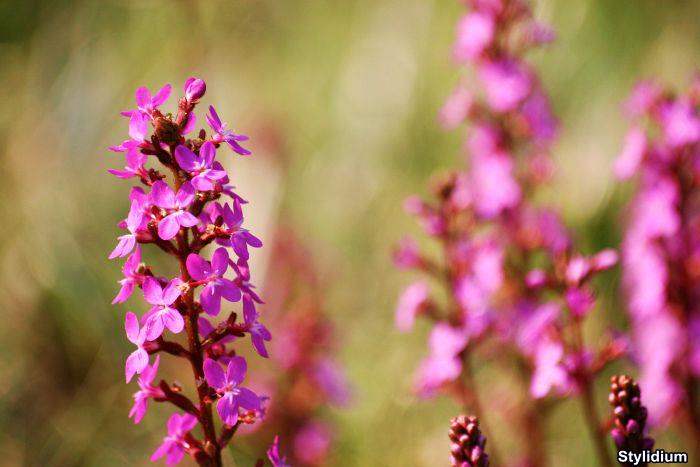
As its name suggests, the Trigger plant Stylidium is a susceptible plant easily triggered by any insect landing on its flower column.
- It also has stalked mucous glands that produce enzymes for digesting its prey.
- Its genus name comes from the Greek word “stylos” which refers to the united male reproductive organ of the flower.
- This plant genus has more than 130 species, which are mostly found in Australia and some in Asia.
![]()
22. Roridula Sp.
| Kingdom | Order | Family | Genus | Species |
|---|---|---|---|---|
| Plantae | Ericales | Roridulaceae | Roridula | Roridula sp. |
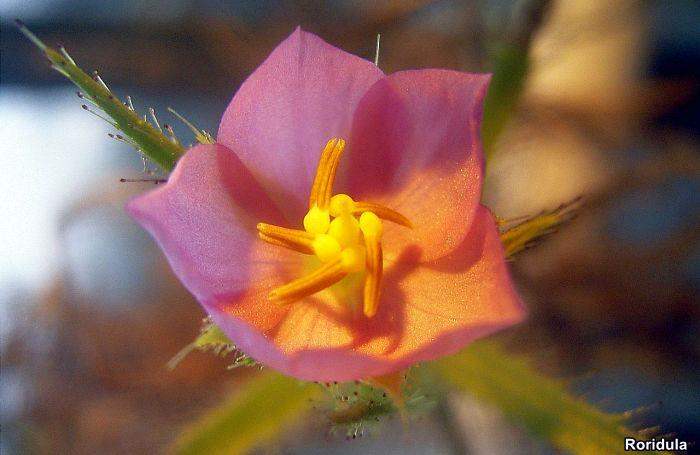
Unlike most plant carnivores, the Roriduladoes does not produce enzymes that can digest the trapped insect.
- Instead, it produces a resin, which is much stronger than the enzyme produced by the sundew.
- To use its captured prey, this plant lives in symbiosis with assassin bugs that can suck the nutrients from the captured insect while the plant absorbs their increments.
- This plant-derived its name from the Latin word “roridos” and Greek word “gorgon” which means “dewy” and “terrible” respectively.
![]()
23. Genlisea Sp.
| Kingdom | Order | Family | Genus | Species |
|---|---|---|---|---|
| Plantae | Lamiales | Lentibulariaceae | Genlisea | Genlisea sp. |
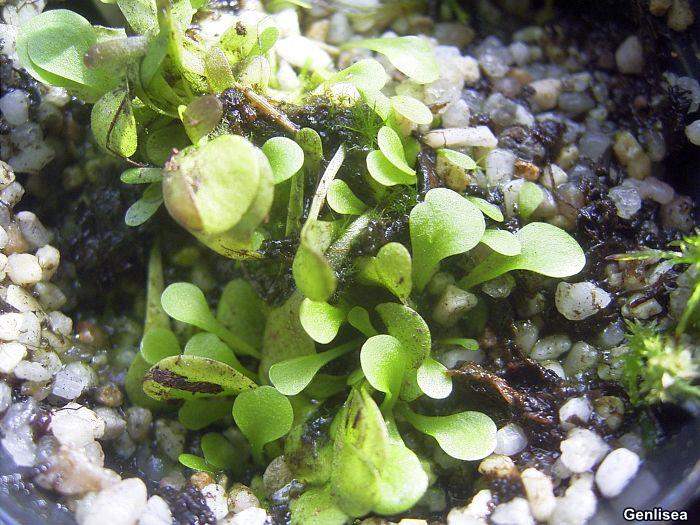
The next carnivorous plant is the Genlisea that grows in wet areas of Madagascar, Zambia, and Tanzania.
- Scientists consider this plant as a close relative to Utricularia as both produce their traps underwater.
- The name of this plant is derived from the name of the French writer Contesse Stéphanie-Félicité du Crest de Saint-Aubin de Genlis.
![]()
24. Jungle Lantern (Catopsis Berteroniana)
| Kingdom | Order | Family | Genus | Species |
|---|---|---|---|---|
| Plantae | Poales | Bromeliaceae | Catopsis | Catopsis berteroniana |

These penultimate carnivorous plants are Endemic to Central America and Southern Brazil
- The Jungle lantern plant is a type of bromeliad famous for its iridescent yellow flower.
- This plant is also covered in a powdery wax that further brightens its color.
- Because of that, it is also referred to as the “Yellow strap plant“.
- Coming from the Greek word “katopsis” which means “view“, this plant with the same name truly gives a beautiful view, especially when seen from its perches in treetops.
- This plant catches insects in its urn-like structure filled with digestive fluids that dissolve its prey. However, scientists still argue whether this plant is a true carnivore.
![]()
25. Philcoxia Minensis
| Kingdom | Order | Family | Genus | Species |
|---|---|---|---|---|
| Plantae | Lamiales | Plantaginaceae | Philcoxia | Philcoxia minensis |
Last but not least carnivorous plants are the Philcoxia minensis, a worm-eating plant endemic to the savannah regions of Brazil. This plant has underwater leaves about the size of pinheads, can trap insects, digest them, and eventually use them as fertilizer for the soil.
![]()
Imagine that you are an insect looking for a place to land. Suddenly, you see a lovely leaf adorned with several hairs on its surface.
You tried to land on it, and after one-tenth of a second, you were caught in a snap. You have no other way out. You have no other choice but to wait inside until you get digested in a few days.
Isn't it a very tragic way to die?
![]()
Cite this page
Bio Explorer. (2026, January 1). 25 Most Famous & Dangerous Bug Eating Plants. https://www.bioexplorer.net/carnivorous-plants.html/



